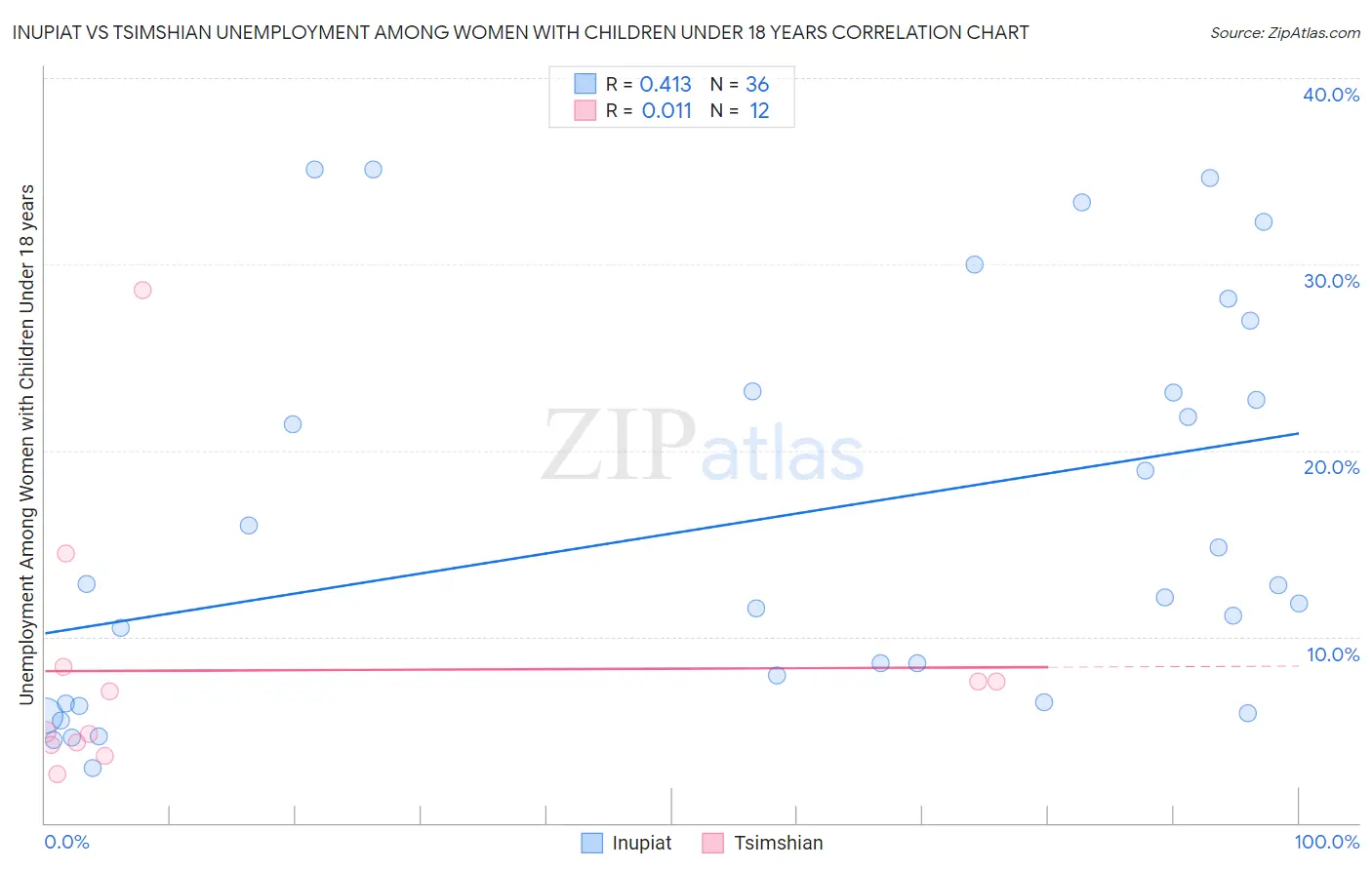Inupiat vs Tsimshian Unemployment Among Women with Children Under 18 years
COMPARE
Inupiat
Tsimshian
Unemployment Among Women with Children Under 18 years
Unemployment Among Women with Children Under 18 years Comparison
Inupiat
Tsimshian
9.6%
UNEMPLOYMENT AMONG WOMEN WITH CHILDREN UNDER 18 YEARS
0.0/ 100
METRIC RATING
344th/ 347
METRIC RANK
5.6%
UNEMPLOYMENT AMONG WOMEN WITH CHILDREN UNDER 18 YEARS
15.2/ 100
METRIC RATING
205th/ 347
METRIC RANK
Inupiat vs Tsimshian Unemployment Among Women with Children Under 18 years Correlation Chart
The statistical analysis conducted on geographies consisting of 94,720,534 people shows a moderate positive correlation between the proportion of Inupiat and unemployment rate among women with children under the age of 18 in the United States with a correlation coefficient (R) of 0.413 and weighted average of 9.6%. Similarly, the statistical analysis conducted on geographies consisting of 15,495,086 people shows no correlation between the proportion of Tsimshian and unemployment rate among women with children under the age of 18 in the United States with a correlation coefficient (R) of 0.011 and weighted average of 5.6%, a difference of 70.7%.

Unemployment Among Women with Children Under 18 years Correlation Summary
| Measurement | Inupiat | Tsimshian |
| Minimum | 2.9% | 2.6% |
| Maximum | 35.1% | 28.6% |
| Range | 32.2% | 26.0% |
| Mean | 16.1% | 8.2% |
| Median | 12.4% | 6.0% |
| Interquartile 25% (IQ1) | 6.5% | 4.3% |
| Interquartile 75% (IQ3) | 23.1% | 8.0% |
| Interquartile Range (IQR) | 16.7% | 3.7% |
| Standard Deviation (Sample) | 10.4% | 7.2% |
| Standard Deviation (Population) | 10.3% | 6.9% |
Similar Demographics by Unemployment Among Women with Children Under 18 years
Demographics Similar to Inupiat by Unemployment Among Women with Children Under 18 years
In terms of unemployment among women with children under 18 years, the demographic groups most similar to Inupiat are Yuman (9.8%, a difference of 1.9%), Arapaho (9.2%, a difference of 4.2%), Puerto Rican (9.0%, a difference of 6.4%), Tohono O'odham (8.9%, a difference of 8.1%), and Yup'ik (11.0%, a difference of 15.1%).
| Demographics | Rating | Rank | Unemployment Among Women with Children Under 18 years |
| Immigrants | Dominican Republic | 0.0 /100 | #333 | Tragic 7.5% |
| Cheyenne | 0.0 /100 | #334 | Tragic 7.8% |
| Apache | 0.0 /100 | #335 | Tragic 7.9% |
| Sioux | 0.0 /100 | #336 | Tragic 7.9% |
| Yakama | 0.0 /100 | #337 | Tragic 8.1% |
| Immigrants | Yemen | 0.0 /100 | #338 | Tragic 8.2% |
| Navajo | 0.0 /100 | #339 | Tragic 8.2% |
| Crow | 0.0 /100 | #340 | Tragic 8.2% |
| Tohono O'odham | 0.0 /100 | #341 | Tragic 8.9% |
| Puerto Ricans | 0.0 /100 | #342 | Tragic 9.0% |
| Arapaho | 0.0 /100 | #343 | Tragic 9.2% |
| Inupiat | 0.0 /100 | #344 | Tragic 9.6% |
| Yuman | 0.0 /100 | #345 | Tragic 9.8% |
| Yup'ik | 0.0 /100 | #346 | Tragic 11.0% |
| Pima | 0.0 /100 | #347 | Tragic 11.7% |
Demographics Similar to Tsimshian by Unemployment Among Women with Children Under 18 years
In terms of unemployment among women with children under 18 years, the demographic groups most similar to Tsimshian are Israeli (5.6%, a difference of 0.050%), Portuguese (5.6%, a difference of 0.080%), Immigrants from Micronesia (5.6%, a difference of 0.23%), Immigrants from Morocco (5.6%, a difference of 0.33%), and Menominee (5.6%, a difference of 0.41%).
| Demographics | Rating | Rank | Unemployment Among Women with Children Under 18 years |
| Arabs | 21.4 /100 | #198 | Fair 5.6% |
| Marshallese | 20.2 /100 | #199 | Fair 5.6% |
| Menominee | 18.6 /100 | #200 | Poor 5.6% |
| Immigrants | Morocco | 17.9 /100 | #201 | Poor 5.6% |
| Immigrants | Micronesia | 17.1 /100 | #202 | Poor 5.6% |
| Portuguese | 15.9 /100 | #203 | Poor 5.6% |
| Israelis | 15.6 /100 | #204 | Poor 5.6% |
| Tsimshian | 15.2 /100 | #205 | Poor 5.6% |
| Nicaraguans | 12.3 /100 | #206 | Poor 5.6% |
| Peruvians | 12.1 /100 | #207 | Poor 5.6% |
| Immigrants | Costa Rica | 11.6 /100 | #208 | Poor 5.6% |
| Immigrants | Western Asia | 11.3 /100 | #209 | Poor 5.6% |
| Immigrants | Nonimmigrants | 10.6 /100 | #210 | Poor 5.7% |
| Panamanians | 10.1 /100 | #211 | Poor 5.7% |
| South Americans | 10.0 /100 | #212 | Poor 5.7% |